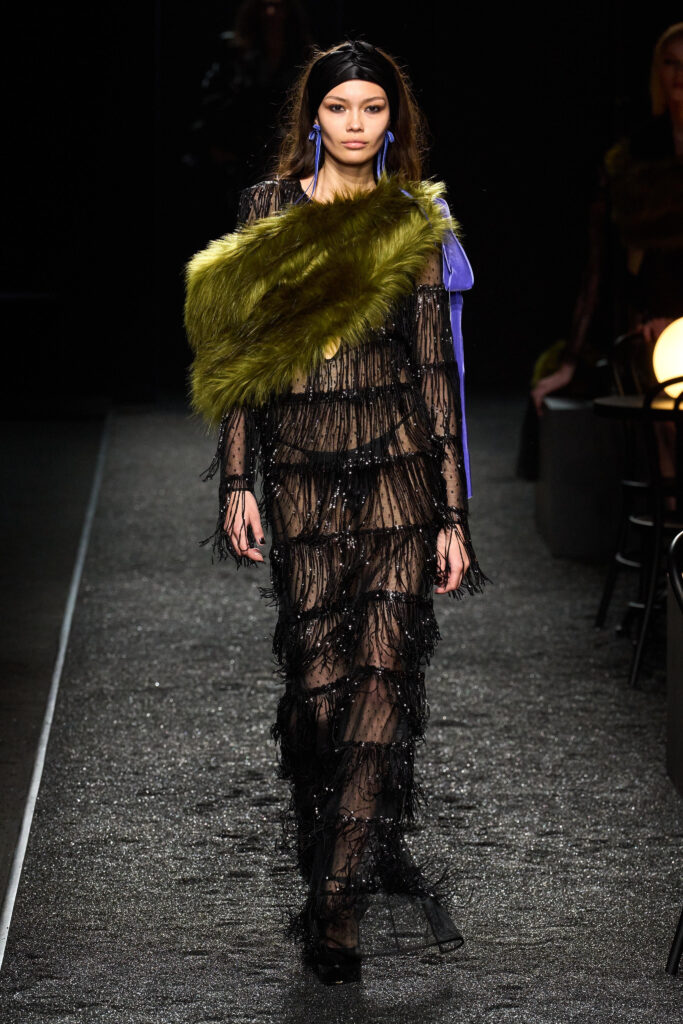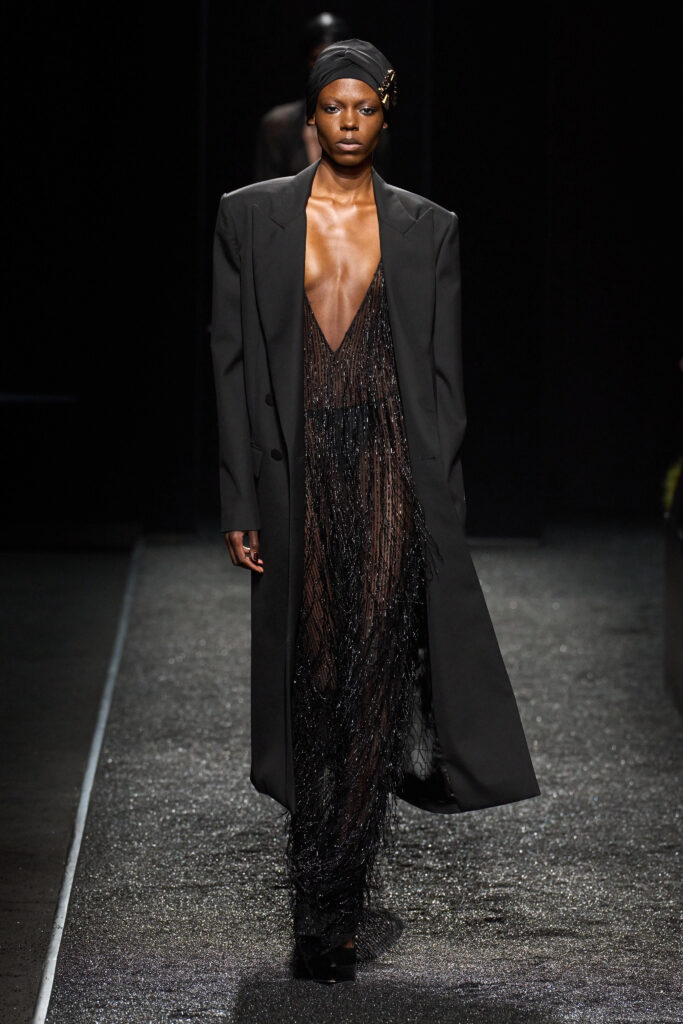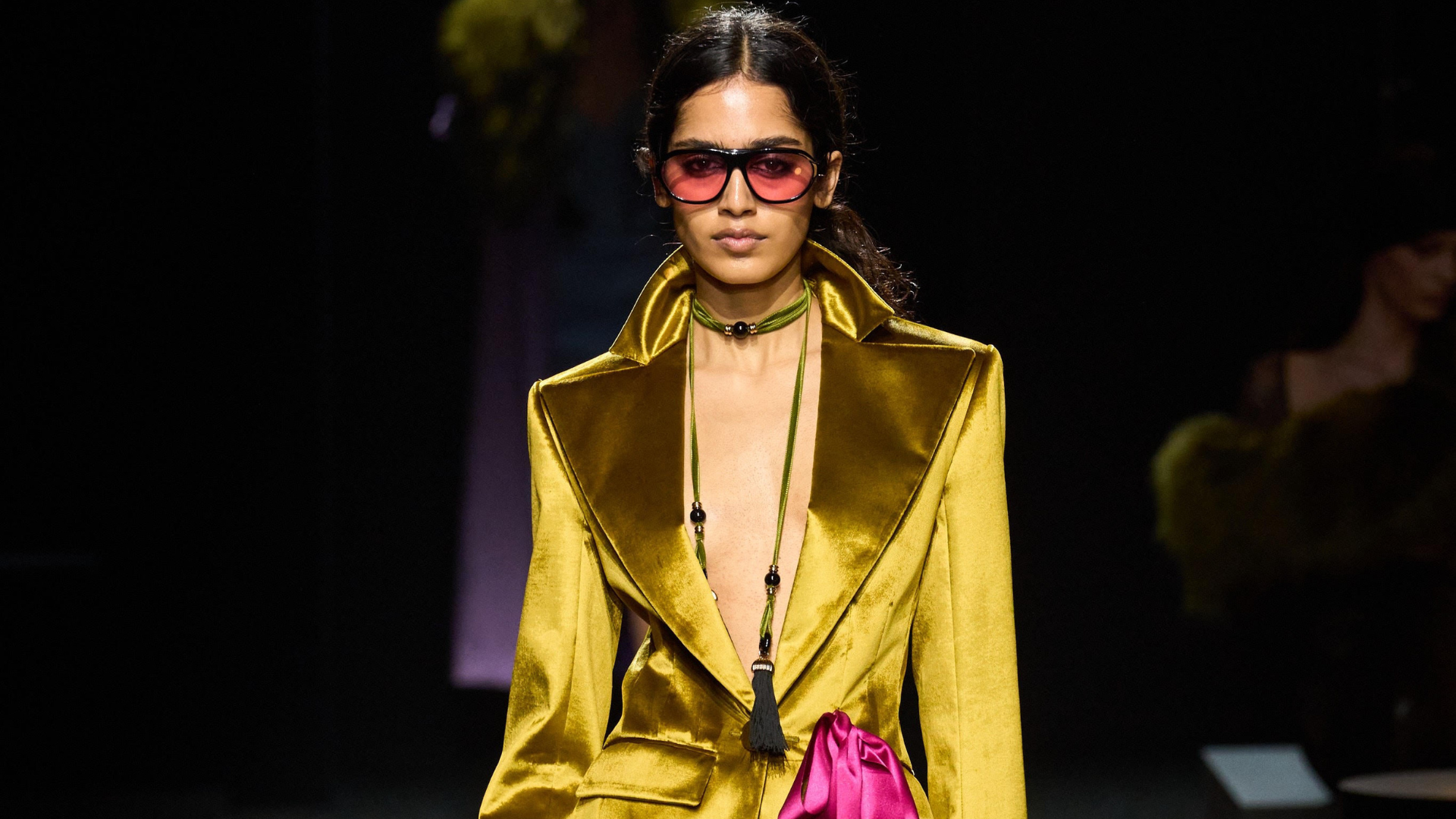Photo Credits: Umberto Fratini
In his fifth show for Nina Ricci, Harris Reed reflected on a moment of clarity that has significantly influenced his latest collection. “For a while, I was so desperate to make people remember what Nina Ricci was, that it was almost two-dimensional,” Reed shared, acknowledging the struggle to revive the iconic brand with an authentic touch. But as he now says, “Ah-ha, I found Nina.”
So, who exactly is Nina in Reed’s eyes? She is an embodiment of French allure, captured in a 1973 Helmut Newton photograph—a woman perched on a car, illuminated by Parisian streetlights. This image became the heartbeat of Reed’s mood board this season, setting the tone for a sensual, late-night re-imagining of the Nina Ricci woman.

Photo Credits: Umberto Fratini
That mood board—and the essence of Nina—was brought to life in an evocative show staged in the dimly lit basement of the Hôtel Salomon de Rothschild. As Reed explained, the collection sought to recreate the mystery and allure of those fleeting, spontaneous moments that define a Parisian night, and in that, he found the Nina Ricci spirit once again.
Reed also found inspiration in French-girl style, particularly through his collaboration with Carine Roitfeld, an iconic figure who has defined a certain effortless chic for decades. “What I love about working with Carine is that now a micro-mini goes with a fabulous oversize faux-fur coat,” Reed mused, highlighting the surprising, unexpected combinations that marked the collection. In a subtle nod to Roitfeld’s influence, Reed deconstructed the traditional wardrobe, pairing sheer blouses with high-waisted trousers and softening structured blazers with shoulder pads tucked inside, rather than perched on the outside. “I love the French word mélange,” Reed added, capturing the essence of his approach: a harmonious blending of diverse elements that speak to modern elegance and freedom.

Photo Credits: Umberto Fratini
The collection was built on rich, tactile materials—black satin, lace, jewel-toned faux-fur stoles, animal-print velvet, and fringe—each invoking the sensuousness of 1970s nightlife. But rather than the statement jewelry often associated with the era, Reed’s approach to adornment was subtler, with draped pieces that evoked the quiet elegance of an ellipsis rather than an exclamation mark. This minimalist approach resulted in a softer, more seductive interpretation of Nina Ricci, moving away from the operatic glamour of recent seasons and embracing a louche, yet equally theatrical, spirit.
In one of the evening’s most memorable moments, four models appeared at café tables along the runway, seducing the audience (or perhaps each other) to the sounds of Tweet and Missy Elliott’s “Oops (Oh My).” The air was thick with intrigue, heightened by a show-stopping finale that saw two models take the stage in feathered arm cuffs that doubled as black angel wings. Reed’s reference to the nightclub scene felt distinctly theatrical, as if the collection were a tribute to a modern, after-dark fantasy.

Photo Credits: Umberto Fratini
One thing Reed learned from his customers—the women wearing Nina Ricci—was that they craved a sense of party ease paired with a gentleman’s jacket. This insight led to the inclusion of key pieces like Le Smoking, the iconic tuxedo jacket famously associated with Yves Saint Laurent. Reed’s adaptation of this classic was both fresh and relevant, a reinvention for a new generation of women who value sophistication with a touch of playful edge.
With his signature pre-Raphaelite curls stealing the spotlight during his bow, Reed’s fifth collection for Nina Ricci felt like the beginning of a new chapter for the brand—one where sensuality, ease, and French cool come together seamlessly. The collection not only celebrates the past but embraces a vibrant, modern take on femininity, promising a future where Nina Ricci’s legacy thrives with renewed purpose.
Video Credits: Nina Ricci Instagram/ Reproduction

Photo Credits: Umberto Fratini

